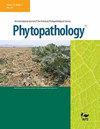Martina Cendoya, Elena Lázaro, Ana Navarro-Quiles, Antonio López-Quílez, David Conesa, Antonio Vicent
求助PDF
{"title":"新植物病害爆发管理计划的绩效:Xylella fastidiosa 在西班牙大陆引起的杏叶焦枯病案例。","authors":"Martina Cendoya, Elena Lázaro, Ana Navarro-Quiles, Antonio López-Quílez, David Conesa, Antonio Vicent","doi":"10.1094/PHYTO-12-23-0465-R","DOIUrl":null,"url":null,"abstract":"<p><p>Outbreak response to quarantine pathogens and pests in the European Union (EU) is regulated by the EU Plant Health Law, but the performance of outbreak management plans in terms of their effectiveness and efficiency has been quantified only to a limited extent. As a case study, the disease dynamics of almond leaf scorch, caused by <i>Xylella fastidiosa</i>, in the affected area of Alicante, Spain, were approximated using an individual-based spatial epidemiological model. The emergence of this outbreak was dated based on phylogenetic studies, and official surveys were used to delimit the current extent of the disease. Different survey strategies and disease control measures were compared to determine their effectiveness and efficiency for outbreak management in relation to a baseline scenario without interventions. One-step and two-step survey approaches were compared with different confidence levels, buffer zone sizes, and eradication radii, including those set by the EU legislation for <i>X. fastidiosa</i>. The effect of disease control interventions was also considered by decreasing the transmission rate in the buffer zone. All outbreak management plans reduced the number of infected trees (effectiveness), but large differences were observed in the number of susceptible trees not eradicated (efficiency). The two-step survey approach, high confidence level, and the reduction in the transmission rate increased the efficiency. Only the outbreak management plans with the two-step survey approach removed infected trees completely, but they required greater survey efforts. Although control measures reduced disease spread, surveillance was the key factor in the effectiveness and efficiency of the outbreak management plans. [Formula: see text] Copyright © 2024 The Author(s). This is an open access article distributed under the CC BY 4.0 International license.</p>","PeriodicalId":20410,"journal":{"name":"Phytopathology","volume":null,"pages":null},"PeriodicalIF":2.6000,"publicationDate":"2024-07-01","publicationTypes":"Journal Article","fieldsOfStudy":null,"isOpenAccess":false,"openAccessPdf":"","citationCount":"0","resultStr":"{\"title\":\"Performance of Outbreak Management Plans for Emerging Plant Diseases: The Case of Almond Leaf Scorch Caused by <i>Xylella fastidiosa</i> in Mainland Spain.\",\"authors\":\"Martina Cendoya, Elena Lázaro, Ana Navarro-Quiles, Antonio López-Quílez, David Conesa, Antonio Vicent\",\"doi\":\"10.1094/PHYTO-12-23-0465-R\",\"DOIUrl\":null,\"url\":null,\"abstract\":\"<p><p>Outbreak response to quarantine pathogens and pests in the European Union (EU) is regulated by the EU Plant Health Law, but the performance of outbreak management plans in terms of their effectiveness and efficiency has been quantified only to a limited extent. As a case study, the disease dynamics of almond leaf scorch, caused by <i>Xylella fastidiosa</i>, in the affected area of Alicante, Spain, were approximated using an individual-based spatial epidemiological model. The emergence of this outbreak was dated based on phylogenetic studies, and official surveys were used to delimit the current extent of the disease. Different survey strategies and disease control measures were compared to determine their effectiveness and efficiency for outbreak management in relation to a baseline scenario without interventions. One-step and two-step survey approaches were compared with different confidence levels, buffer zone sizes, and eradication radii, including those set by the EU legislation for <i>X. fastidiosa</i>. The effect of disease control interventions was also considered by decreasing the transmission rate in the buffer zone. All outbreak management plans reduced the number of infected trees (effectiveness), but large differences were observed in the number of susceptible trees not eradicated (efficiency). The two-step survey approach, high confidence level, and the reduction in the transmission rate increased the efficiency. Only the outbreak management plans with the two-step survey approach removed infected trees completely, but they required greater survey efforts. Although control measures reduced disease spread, surveillance was the key factor in the effectiveness and efficiency of the outbreak management plans. [Formula: see text] Copyright © 2024 The Author(s). This is an open access article distributed under the CC BY 4.0 International license.</p>\",\"PeriodicalId\":20410,\"journal\":{\"name\":\"Phytopathology\",\"volume\":null,\"pages\":null},\"PeriodicalIF\":2.6000,\"publicationDate\":\"2024-07-01\",\"publicationTypes\":\"Journal Article\",\"fieldsOfStudy\":null,\"isOpenAccess\":false,\"openAccessPdf\":\"\",\"citationCount\":\"0\",\"resultStr\":null,\"platform\":\"Semanticscholar\",\"paperid\":null,\"PeriodicalName\":\"Phytopathology\",\"FirstCategoryId\":\"97\",\"ListUrlMain\":\"https://doi.org/10.1094/PHYTO-12-23-0465-R\",\"RegionNum\":2,\"RegionCategory\":\"农林科学\",\"ArticlePicture\":[],\"TitleCN\":null,\"AbstractTextCN\":null,\"PMCID\":null,\"EPubDate\":\"2024/7/13 0:00:00\",\"PubModel\":\"Epub\",\"JCR\":\"Q2\",\"JCRName\":\"PLANT SCIENCES\",\"Score\":null,\"Total\":0}","platform":"Semanticscholar","paperid":null,"PeriodicalName":"Phytopathology","FirstCategoryId":"97","ListUrlMain":"https://doi.org/10.1094/PHYTO-12-23-0465-R","RegionNum":2,"RegionCategory":"农林科学","ArticlePicture":[],"TitleCN":null,"AbstractTextCN":null,"PMCID":null,"EPubDate":"2024/7/13 0:00:00","PubModel":"Epub","JCR":"Q2","JCRName":"PLANT SCIENCES","Score":null,"Total":0}
引用次数: 0
引用
批量引用

 求助内容:
求助内容: 应助结果提醒方式:
应助结果提醒方式:


